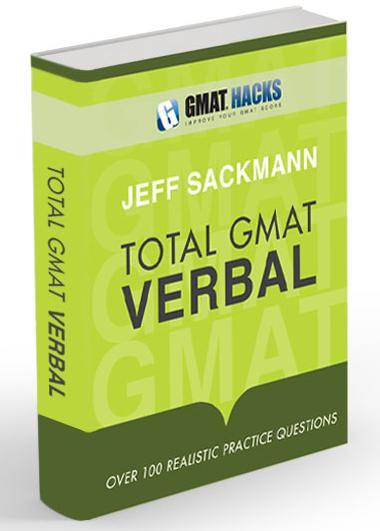
Bookshelf
|
|
Total GMAT Math Jeff's complete Quant guide, on sale now! |
|
|
Total GMAT Verbal Everything you need to ace GMAT Verbal! |
1,800 Practice Math Questions
Buy Jeff's books at Amazon.com

GMAT Official Guide, with IR
OG Math | OG Verbal
OG12 & Quant Rev solutions!
GMAT Question of the Day
Beginner's Guide to the GMAT
GMAT Hacks Affiliate Program

Recent Hacks

Categories
- General Study Tips
- Goals and Planning
- CAT Strategy
- The Mental Game
- GMAT Math Strategy
- GMAT Math Topics
- Mental Math
- Data Sufficiency
- Critical Reasoning
- Reading Comprehension
- Sentence Correction
- Analytical Writing Assessment
- Integrated Reasoning
- IR Explained
- Business School Admissions
- GMAT Prep Resources
- Practice Questions
- Total GMAT Math
- Total GMAT Verbal
- GMAT 111

GMAT Focus Review
| You should follow me on Twitter. While you're at it, take a moment to subscribe to GMAT Hacks via RSS or Email. |
Several months ago, MBA.com released a new GMAT practice product called GMAT Focus. It offers three quantitative diagnostic tests of 24 questions each. The tests are adaptive, just like the GMAT itself, and the format of the tests is very similar to the actual exam.
For now, GMAT Focus is only available for quant practice--there's no equivalent verbal diagnostic. Each test costs $25, and you can get a discount ($65 instead of $75) if you buy all three tests.
GMAT Focus Content
As you might expect, the test items in the GMAT Focus diagnostics are similar to those of the Official Guides and the GMATPrep practice tests.
I tried to get every question right, so I worked through the harder items in the Focus database, and I found those to be slightly more difficult than comparable items in either GMATPrep or the Official Guides.
In terms of types of content, there were no surprises. No unfamiliar geometry figures, no complicated standard deviation, no unprecedented combinatorics. Every topic on the test is covered in Total GMAT Math. That said, you'll always see items on the GMAT that require looking at a topic in a different way, and the Focus diagnostics were no different in that regard.
Everything I've written so far is just another way of saying that the GMAT Focus questions are very test-like. There's little else you can ask from a practice test.
Reviewing Your GMAT Focus Results
The post-test experience is far superior to that of GMATPrep. The biggest step forward is that explanations are provided. They aren't great explanations--they are similar to those in the OG--but it's helpful to have them there.
In other regards, the test review portion of GMAT Focus is much more like the reviews offered by test-prep companies. You get a breakdown of your strong and weak areas, as well as the amount of time you spent on each question.
Instead of a specific number, GMAT Focus gives you a range of quant scores. Quantitative section scores can be as low as 6 and as high as 51. After the diagnostic test, you get a range. Mine was 49-51, but most people report ranges much wider, such as 40-48.
I've heard some complaints that ranges that wide are meaningless. It's true that you can't translate them directly into a GMAT score prediction, but it's not so much that they're meaningless, it's that they're honest.
I recently wrote about how to interpret your GMATPrep scores, and noted that they can't be read that precisely. Since the GMAT Focus diagnostics are 24 questions instead of the full 37, they are even less precise.
If you'd like something more specific, just take the average of your score range--if that is 40-48, say you got a 44. Apply the same reasoning to that score that you would to a GMATPrep score, and you'll find yourself predicting a 40-48 on the exam itself!
GMAT Focus Recommendation
GMAT Focus diagnostics aren't designed to be full-length practice tests, so you can't really use them as such. They are 2/3 the length of the actual quant section, and there is no verbal. However, they provide a great way to practice quant under realistic, timed conditions.
As I've written many times on this site, I don't recommend taking tons of practice tests--the two GMATPrep exams are plenty. That said, if you are having trouble mastering the timing aspect of GMAT math, GMAT Focus may be just what you need.
About the author: Jeff Sackmann has written many GMAT preparation books, including the popular Total GMAT Math, Total GMAT Verbal, and GMAT 111. He has also created explanations for problems in The Official Guide, as well as 1,800 practice GMAT math questions.
 |
Total GMAT Verbal
The comprehensive guide to the GMAT Verbal section. Recognize, dissect, and master every question type
you'll face on the test. Everything you need, all in one place, including 100+ realistic practice questions. |